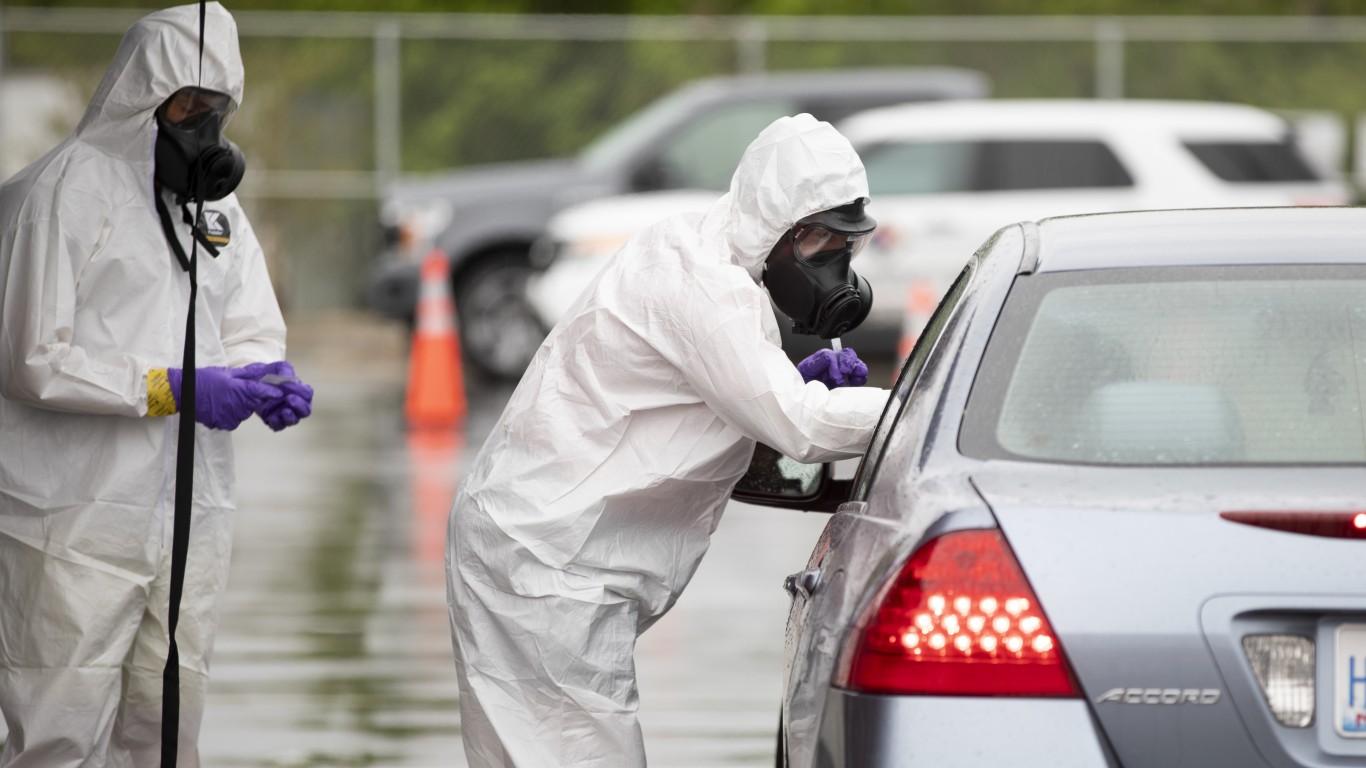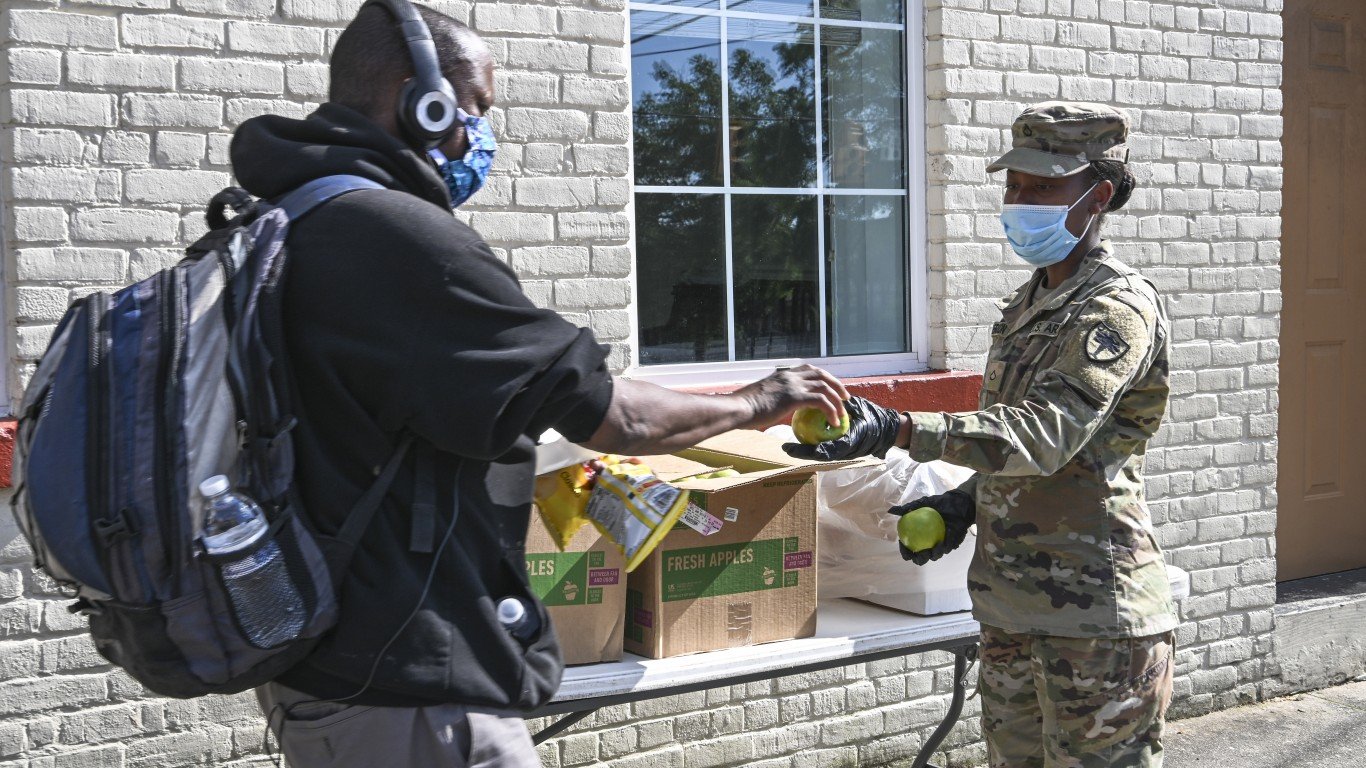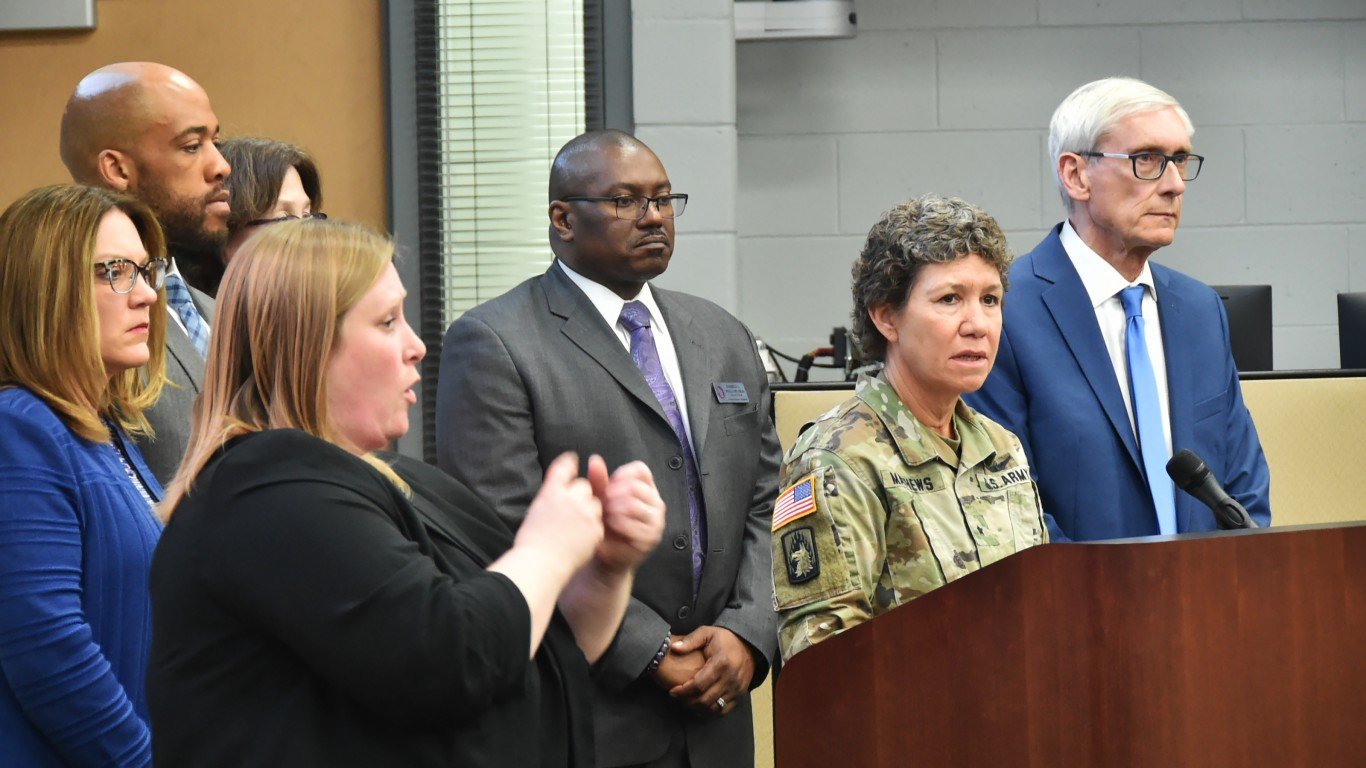

The U.S. has confirmed more than 1.7 million cases of COVID-19 — more than 102,000 of them fatal. The rate of daily new cases nationwide has declined throughout May, though there is concern that it could begin to spike again. Businesses have started reopening as states have begun to relax stay-at-home orders and social distancing measures they put in place to curb the spread of the novel coronavirus.
To determine each state’s social distancing measures and restrictions on movement, 24/7 Wall St. reviewed executive orders from state governors since the first COVID-19 case was confirmed in the United States at the end of January.
States in the northeast that have been particularly hard-hit by the coronavirus — like New York and New Jersey — have had some of the lengthiest and most severe measures enacted to restrict the spread of COVID-19, and still remain largely closed down.
Other states began pulling back on their orders as early as late April, and seven never enacted them at all. The rate of infections has slowed over the last month in many of the states with more restrictive measures. Meanwhile, COVID-19 daily infections have increased rapidly in a number of less restrictive states, including in Iowa and South Dakota, which never enforced a stay at home order.
Though the spread of coronavirus appears to be slowing, every state has had at least one new case from May 18 to May 25, and some have confirmed well over 1,000 new cases in their state during that time. These are the states where the virus is growing the fastest right now.
It is important to note that, while confirmed infections appear to be trending downwards, there are likely many thousands of people who become infected and are asymptomatic. According to the Centers for Disease Control and Prevention, there were likely thousands of undiagnosed deaths that occurred during the pandemic. This is how COVID-19 is being underreported in most states.
These are every state’s rules for staying home and social distancing.
Alabama
> Confirmed COVID-19 cases as of May 27: 328 per 100,000 people — 22nd highest (total: 16,032)
> COVID-19 related deaths as of May 27: 12 per 100,000 people — 24th highest (total: 583)
> Tests as of May 27: 4,049 per 100,000 people — 22nd lowest (total: 197,928)
> Date of first confirmed case: 3/13/2020
> Est. peak date: 4/19/2020 (est. 1,873 active infections)
> Population: 4,887,871
Alabama’s stay-at-home order expired on April 30, and the state’s subsequent safer-at-home policy expired on May 22. Under the state’s currently standing rules, entertainment venues and summer camps are allowed to reopen, provided they adhere to proper sanitation and social distancing. Schools will be allowed to reopen on June 1 under the same conditions. Employees at educational institutions will also need to wear face masks. These terms will remain in place until July 3 at the earliest.
[in-text-ad]
Alaska
> Confirmed COVID-19 cases as of May 27: 56 per 100,000 people — 3rd lowest (total: 412)
> COVID-19 related deaths as of May 27: 1 per 100,000 people — 2nd lowest (total: 10)
> Tests as of May 27: 6,287 per 100,000 people — 11th highest (total: 46,363)
> Date of first confirmed case: 3/12/2020
> Est. peak date: 3/18/2020 (est. 100 active infections)
> Population: 737,438
Alaska’s stay-at-home order expired on April 24, and on May 22, Gov. Mike Dunleavy allowed all businesses in the state to reopen at 100% capacity. Local communities, however, still have the option to impose their own restrictions. Despite reopening, all travelers arriving in Alaska must complete a two-week quarantine.
Arizona
> Confirmed COVID-19 cases as of May 27: 241 per 100,000 people — 17th lowest (total: 17,262)
> COVID-19 related deaths as of May 27: 12 per 100,000 people — 25th highest (total: 831)
> Tests as of May 27: 2,737 per 100,000 people — 3rd lowest (total: 196,266)
> Date of first confirmed case: 1/26/2020
> Est. peak date: 6/20/2020 (est. 13,974 active infections)
> Population: 7,171,646
The stay-at-home order expired on May 15. Elective medical procedures have been allowed to resume; some nonessential businesses opened for delivery services; and in-store sales were allowed to resume on May 8. Restaurants, which opened for dine-in on May 11, must limit capacity. Gyms and spas were allowed to reopen on May 13, and movie theaters on May 15, but they have to abide by federal social distancing rules. Major leagues sports can resume games but with no fans. Pools can also open with social distancing and enhanced sanitation. More work sectors can reopen incrementally, but employers and their personnel are still encouraged to work remotely whenever possible.
Arkansas
> Confirmed COVID-19 cases as of May 27: 208 per 100,000 people — 14th lowest (total: 6,277)
> COVID-19 related deaths as of May 27: 4 per 100,000 people — 7th lowest (total: 120)
> Tests as of May 27: 3,937 per 100,000 people — 21st lowest (total: 118,641)
> Date of first confirmed case: 3/11/2020
> Est. peak date: 4/14/2020 (est. 571 active infections)
> Population: 3,013,825
Arkansas was one of a handful of states to never issue a statewide stay-at-home order, but nonessential businesses were closed for a period. Establishments like gyms and barbershops began reopening in early May. Since May 11, restaurants have resumed dine-in services but with limitations — they can only seat a third of their total capacity. If cases in the state continue to decline, restaurants will be able to operate at two-thirds capacity. High school and community sports teams will be allowed to resume practice events starting June 1, under strict measures.
[in-text-ad-2]

California
> Confirmed COVID-19 cases as of May 27: 250 per 100,000 people — 19th lowest (total: 98,980)
> COVID-19 related deaths as of May 27: 10 per 100,000 people — 23rd lowest (total: 3,884)
> Tests as of May 27: 4,391 per 100,000 people — 24th highest (total: 1,736,894)
> Date of first confirmed case: 1/25/2020
> Est. peak date: 4/5/2020 (est. 10,420 active infections)
> Population: 39,557,045
A stay-at-home order, which has no set end date, is still in effect, though some restrictions are being lifted. The state is reopening at the county level — with counties that meet certain criteria allowed to lift certain restrictions.
In general, Californians are still ordered to stay at their place of residence, except for permitted work, local shopping, or other permitted errands. Small businesses were able to reopen for curbside pickup starting May 8. Businesses will have to follow social distancing guidelines, and employees will have to wear protective gear. Shopping centers, strip malls, and some offices can reopen. Booksellers, sporting goods stores, florists, clothing stores, and other retail shops are allowed to sell merchandise with curbside pickup.
Colorado
> Confirmed COVID-19 cases as of May 27: 435 per 100,000 people — 18th highest (total: 24,767)
> COVID-19 related deaths as of May 27: 24 per 100,000 people — 13th highest (total: 1,392)
> Tests as of May 27: 2,823 per 100,000 people — 5th lowest (total: 160,796)
> Date of first confirmed case: 3/5/2020
> Est. peak date: 4/5/2020 (est. 4,757 active infections)
> Population: 5,695,564
Colorado’s stay-at-home order expired on April 26, and its less restrictive safer-at-home order expired on May 27. Under current orders, restaurants can operate at 50% capacity or with 50 customers — whichever is less — but bars remain closed.
Retailers in the state were allowed to reopen on May 1, and nonessential office work resumed on May 4. State park campsites have been open since May 12. Grocery stores, firearm stores, marijuana dispensaries, and gas stations are all open.
[in-text-ad]
Connecticut
> Confirmed COVID-19 cases as of May 27: 1,156 per 100,000 people — 5th highest (total: 41,288)
> COVID-19 related deaths as of May 27: 106 per 100,000 people — 3rd highest (total: 3,803)
> Tests as of May 27: 6,592 per 100,000 people — 8th highest (total: 235,525)
> Date of first confirmed case: 3/8/2020
> Est. peak date: 4/4/2020 (est. 11,098 active infections)
> Population: 3,572,665
The stay-at-home order expired in Connecticut on May 20, allowing grocery stores and offices to operate at half capacity. Hair salons and barbershops will remain closed in the state until June 1. Starting on June 20, establishments like gyms, hotels, restaurants will be allowed to reopen, and gatherings of more than five people will be allowed. Summer camps and summer schools will remain closed until July 6. When distances of 6 feet between people in public is not possible, face masks are required.
Delaware
> Confirmed COVID-19 cases as of May 27: 940 per 100,000 people — 6th highest (total: 9,096)
> COVID-19 related deaths as of May 27: 36 per 100,000 people — 11th highest (total: 344)
> Tests as of May 27: 5,730 per 100,000 people — 13th highest (total: 55,421)
> Date of first confirmed case: 3/11/2020
> Est. peak date: 4/29/2020 (est. 1,245 active infections)
> Population: 967,171
The stay-at-home order has been extended until May 31. When out, people must maintain at least a 6-foot distance from each other, and those over the age of 12 must wear a face mask. Travelers from outside the state have to self-quarantine for 14 days.
Though the stay-at-home order remains in place, starting May 20, retail establishments, including clothing and shoe stores, were allowed to operate by appointment. On May 22, beaches and pools were allowed to reopen. Restaurants and bars can now apply to their local municipal or county jurisdiction to expand outdoor seating, effective June 1. Indoor services are limited to 30% capacity.
Florida
> Confirmed COVID-19 cases as of May 27: 247 per 100,000 people — 18th lowest (total: 52,634)
> COVID-19 related deaths as of May 27: 11 per 100,000 people — 24th lowest (total: 2,319)
> Tests as of May 27: 4,391 per 100,000 people — 23rd highest (total: 935,271)
> Date of first confirmed case: 3/1/2020
> Est. peak date: 4/19/2020 (est. 4,996 active infections)
> Population: 21,299,325
Since Florida’s stay-at-home order expired on May 4, retailers and restaurants have reopened, operating at 25% capacity. Social distancing is voluntary in churches, and lodging businesses can operate at 50% capacity. Businesses in the Keys remain closed to visitors until June. Though parks, marinas, and golf courses have reopened, gatherings of more than 10 people are not permitted and face masks are usually required. Boats must remain 50 feet apart.
[in-text-ad-2]
Georgia
> Confirmed COVID-19 cases as of May 27: 424 per 100,000 people — 19th highest (total: 44,642)
> COVID-19 related deaths as of May 27: 18 per 100,000 people — 15th highest (total: 1,944)
> Tests as of May 27: 4,190 per 100,000 people — 24th lowest (total: 440,756)
> Date of first confirmed case: 3/2/2020
> Est. peak date: 4/10/2020 (est. 5,892 active infections)
> Population: 10,519,475
Though the shelter-in-place order expired on April 30, older state residents and other at-risk individuals remain under shelter-in-place orders until June 12. Additionally, all Georgians are encouraged to remain home whenever possible and to maintain a distance of at least 6 feet in public.
Some businesses, including gyms and hair salons are allowed to reopen. Places of entertainment such as bowling alleys, theaters, restaurants, and private social clubs are allowed to open as well. Bars, nightclubs, amusement parks, public swimming pools, and live performance venues are to remain closed until May 31. Restaurants can allow 10 customers per 500 square feet of space and accommodate tables with a maximum of 10 people.
Hawaii
> Confirmed COVID-19 cases as of May 27: 45 per 100,000 people — 2nd lowest (total: 644)
> COVID-19 related deaths as of May 27: 1 per 100,000 people — the lowest (total: 17)
> Tests as of May 27: 3,649 per 100,000 people — 17th lowest (total: 51,839)
> Date of first confirmed case: 3/6/2020
> Est. peak date: 3/17/2020 (est. 84 active infections)
> Population: 1,420,491
Stay-at-home and work-at-home orders are in effect until May 31 in Hawaii. People must quarantine themselves for two weeks if traveling between islands or risk fines up to $5,000 and a year in prison — rules that will remain in effect through June 30, 2020.
Some restrictions have been eased, however. Beaches are now open for recreational activities and as long as social distance is maintained. Malls, car washes, nonemergency medical visits, and retailers are now allowed to reopen.
[in-text-ad]

Idaho
> Confirmed COVID-19 cases as of May 27: 154 per 100,000 people — 7th lowest (total: 2,699)
> COVID-19 related deaths as of May 27: 5 per 100,000 people — 9th lowest (total: 81)
> Tests as of May 27: 2,438 per 100,000 people — the lowest (total: 42,776)
> Date of first confirmed case: 3/13/2020
> Est. peak date: 3/27/2020 (est. 378 active infections)
> Population: 1,754,208
Idaho’s stay-at-home order expired on April 30, and the state is in the midst of a multistage reopening plan. Effective May 30, the state’s Department of Health and Welfare encourages all visitors to self-quarantine for 14 days and discourages residents from attending gatherings of 50 or more people — public or private. The state still encourages face mask use and maintaining 6 feet of distance from others in public. While businesses like gyms, barbershops, and restaurants have been allowed to reopen, night clubs and places like concert and sports venues must remain closed.
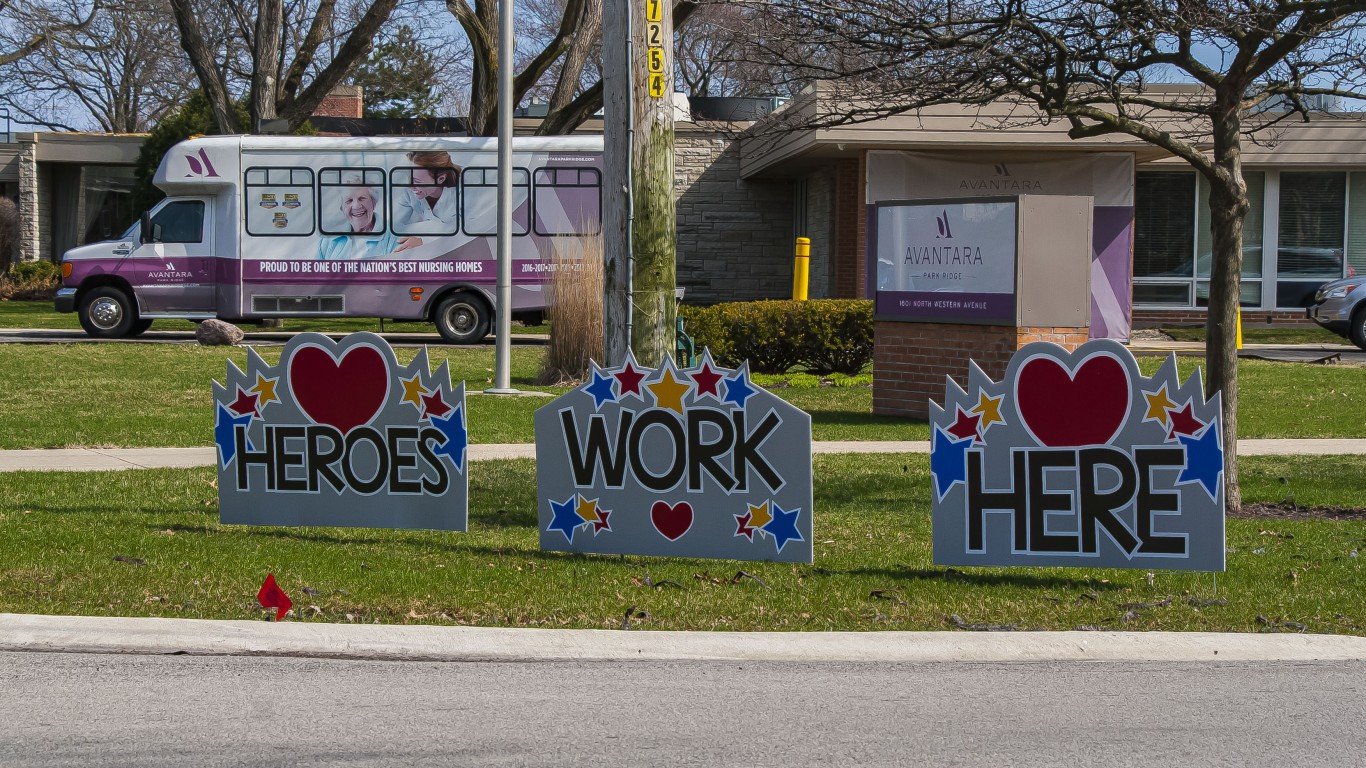
Illinois
> Confirmed COVID-19 cases as of May 27: 897 per 100,000 people — 7th highest (total: 114,306)
> COVID-19 related deaths as of May 27: 40 per 100,000 people — 9th highest (total: 5,083)
> Tests as of May 27: 6,310 per 100,000 people — 10th highest (total: 803,973)
> Date of first confirmed case: 1/24/2020
> Est. peak date: 4/27/2020 (est. 15,777 active infections)
> Population: 12,741,080
Illinois is one of the hardest-hit states by the virus and the state’s shelter-in-place order is in effect at least until May 30. Some restrictions were loosened starting May 1, including resumption of elective surgeries, golfing, and allowing nurseries and garden centers to reopen. Retail stores can offer delivery or pickup services. All state parks, and the concession stands in them, will open by May 29. Fishing and boating will be allowed in groups of no more than 10, up from two. Restaurants can open for outdoor sitting at the end of the month as well. Anyone over the age of 2 must wear a face covering when indoors at a public space or when outdoors at a public place where a 6-foot distance between people cannot be maintained.
Indiana
> Confirmed COVID-19 cases as of May 27: 485 per 100,000 people — 15th highest (total: 32,437)
> COVID-19 related deaths as of May 27: 28 per 100,000 people — 12th highest (total: 1,871)
> Tests as of May 27: 3,517 per 100,000 people — 15th lowest (total: 235,333)
> Date of first confirmed case: 3/6/2020
> Est. peak date: 4/12/2020 (est. 5,533 active infections)
> Population: 6,691,878
The stay-at-home order expired on May 4. Most of the state began phase 3 of its reopening on May 22, with the three delayed counties — Lake, Marion, and Cass (which are the hardest hit counties) — possibly joining on June 1. Also on June 1, public gatherings can have up to 50 people. Malls and other nonessential retailers as well as restaurants can open at 75% capacity. Restaurants in Indianapolis were allowed to open for outdoor dining on May 29. On May 27, Indianapolis Mayor Joe Hogsett and Marion County Public Health Department Director Virginia Caine said starting May 29, places of worship can resume indoor service at 50% capacity with social distancing and mandatory face coverings. Retail stores, public libraries, and offices have opened. Some businesses, like dentists, greenhouses, nurseries, and pet groomers, are allowed to reopen with restrictions. Gyms and fitness centers will be allowed to reopen on June 1. Outside, people must maintain a 6-foot distance from others and are encouraged to wear face coverings.
[in-text-ad-2]
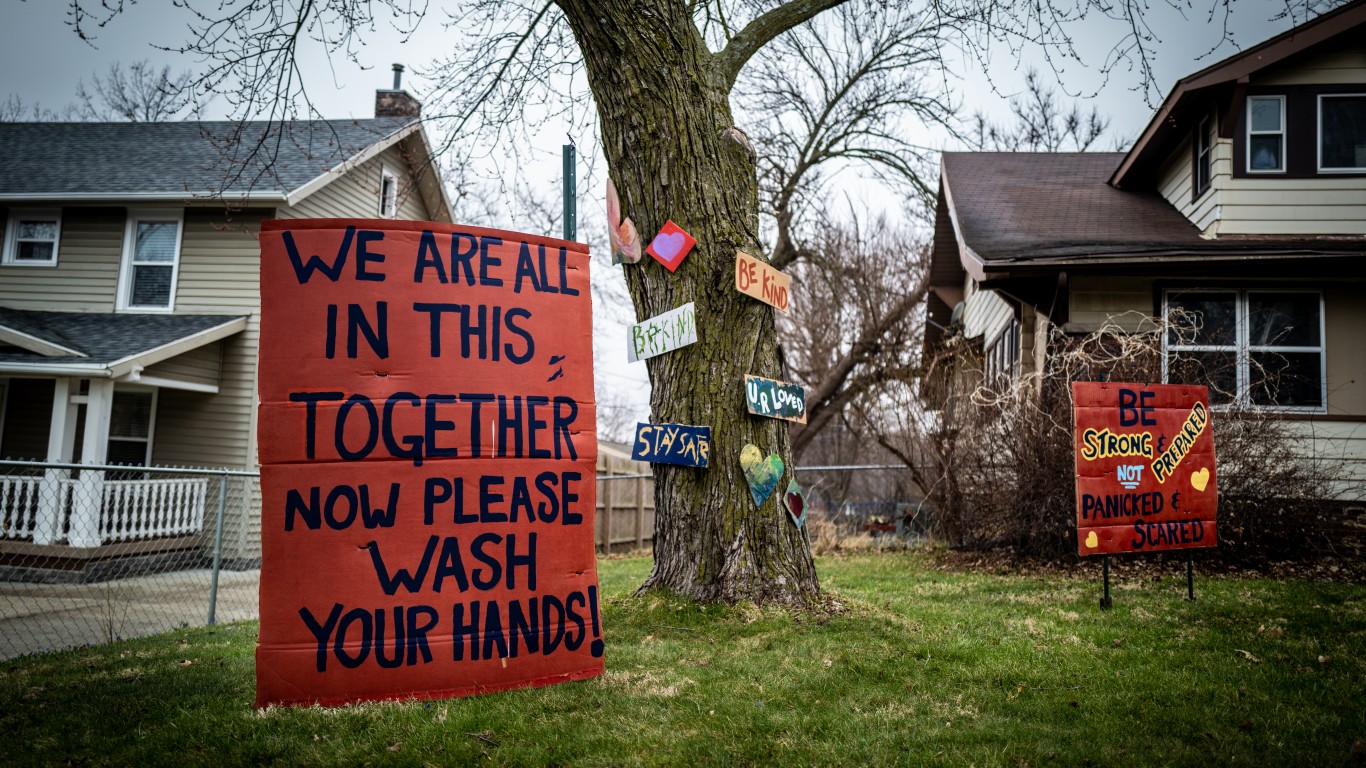
Iowa
> Confirmed COVID-19 cases as of May 27: 578 per 100,000 people — 11th highest (total: 18,256)
> COVID-19 related deaths as of May 27: 15 per 100,000 people — 20th highest (total: 485)
> Tests as of May 27: 4,409 per 100,000 people — 22nd highest (total: 139,140)
> Date of first confirmed case: 3/8/2020
> Est. peak date: 5/15/2020 (est. 1,834 active infections)
> Population: 3,156,145
The state never issued a statewide stay-at-home order but instituted some restriction on nonessential businesses. Iowa Gov. Kim Reynolds announced that, subject to some restrictions, more businesses may reopen June 1, and sports and outdoor performances may resume. The announcement applies to speedways, racetracks, and amphitheaters. Casinos are also allowed to reopen, as well as amusement parks, bowling alleys, pool halls, and arcades. These venues are allowed to reopen at 50% capacity and maintain social distancing requirements.
Kansas
> Confirmed COVID-19 cases as of May 27: 321 per 100,000 people — 24th highest (total: 9,337)
> COVID-19 related deaths as of May 27: 7 per 100,000 people — 14th lowest (total: 205)
> Tests as of May 27: 2,902 per 100,000 people — 6th lowest (total: 84,488)
> Date of first confirmed case: 3/7/2020
> Est. peak date: 4/1/2020 (est. 670 active infections)
> Population: 2,911,510
The temporary statewide stay-home order expired on May 4. A phased reopening began the next day. The second phase of the reopening began May 22 and will last through June 7. Restaurants can open if they maintain social distancing and limit crowds. Hair salons, gyms, casinos, museums, and theaters remain closed. Organized sports, community swimming pools, festivals, parades, and graduation ceremonies are not allowed. Gatherings of more than 15 people are prohibited. Bars and restaurants must preserve a 6-foot distance between tables, booths, and barstools. Casinos and indoor leisure spaces can open as well.
Phase 2 is scheduled to last until June 7. After that date, gatherings of up to 45 people are permitted.
[in-text-ad]
Kentucky
> Confirmed COVID-19 cases as of May 27: 203 per 100,000 people — 12th lowest (total: 9,077)
> COVID-19 related deaths as of May 27: 9 per 100,000 people — 20th lowest (total: 400)
> Tests as of May 27: 4,072 per 100,000 people — 23rd lowest (total: 181,948)
> Date of first confirmed case: 3/6/2020
> Est. peak date: 4/4/2020 (est. 1,139 active infections)
> Population: 4,468,402
On May 22, Kentucky lifted its interstate travel ban and allowed restaurants to reopen at 33% capacity, and with outdoor seating. As of May 25, barbershops, salons and cosmetology businesses were permitted to reopen, and 10-person gatherings were allowed. Movie theaters and fitness centers can reopen on June 1, and museums, outdoor attractions, aquariums, libraries, and distilleries may reopen on June 8. Campgrounds can reopen on June 11 as can childcare services, with reduced capacity, on June 15.
Louisiana
> Confirmed COVID-19 cases as of May 27: 826 per 100,000 people — 8th highest (total: 38,497)
> COVID-19 related deaths as of May 27: 56 per 100,000 people — 6th highest (total: 2,617)
> Tests as of May 27: 7,460 per 100,000 people — 6th highest (total: 347,647)
> Date of first confirmed case: 3/9/2020
> Est. peak date: 3/28/2020 (est. 8,982 active infections)
> Population: 4,659,978
The stay-at-home order expired on May 15 and the state entered phase 1 of reopening, which will last at least through June 5. Some restrictions will stay in place. Everyone in Louisiana should wear masks when in public. Banks, gas stations, and veterinary services are open. Restaurants can open at 25% capacity. They need to have 6 feet between customers and 10 feet between tables. Gatherings are limited to 10 people. Movie theaters, churches, and gyms can reopen with strict physical distancing protocols.

Maine
> Confirmed COVID-19 cases as of May 27: 160 per 100,000 people — 10th lowest (total: 2,137)
> COVID-19 related deaths as of May 27: 6 per 100,000 people — 12th lowest (total: 81)
> Tests as of May 27: 3,446 per 100,000 people — 13th lowest (total: 46,123)
> Date of first confirmed case: 3/12/2020
> Est. peak date: 4/5/2020 (est. 235 active infections)
> Population: 1,338,404
The stay-at-home order is set to expire on May 31. An executive order requiring travelers to the state to self-quarantine for 14 days is in effect at least until the end of August. People are required to wear cloth face coverings in public. Residents can visit businesses such as hair salons and barbershops under phase 1 of the reopening, which started May 1. Under the Rural Reopening Plan, retail stores in 12 of 16 counties opened on May 11. Drive-in movies, stay-in-your-vehicle religious services, and golf are allowed. Private campgrounds were allowed to open on May 22. Another phase of the reopening is scheduled for June, when fitness centers and retail stores may be allowed to reopen. Restaurants in York, Cumberland, and Androscoggin counties may open to outdoor dining service on June 1. Dine-in service is not permitted. Dine-in and outdoor service will be permitted in Penobscot County starting June 1. Reopenings in more populous areas are not scheduled until June.
[in-text-ad-2]
Maryland
> Confirmed COVID-19 cases as of May 27: 801 per 100,000 people — 9th highest (total: 48,423)
> COVID-19 related deaths as of May 27: 40 per 100,000 people — 10th highest (total: 2,392)
> Tests as of May 27: 4,337 per 100,000 people — 25th highest (total: 262,055)
> Date of first confirmed case: 3/5/2020
> Est. peak date: 4/10/2020 (est. 6,102 active infections)
> Population: 6,042,718
The stay-at-home order expired on May 15. A safer-at-home advisory is in effect but won’t be enforced. Manufacturing, retail, haircuts, and worship services were allowed to resume at 50% capacity. Social distancing is still required everywhere. Public beaches have been allowed to open for exercise, but social distancing must be followed. Restaurants may reopen for outdoor dining May 29, and youth sports leagues, day camps, outdoor pools, and drive-in movie theaters were also allowed to reopen on that date.
Massachusetts
> Confirmed COVID-19 cases as of May 27: 1,365 per 100,000 people — 3rd highest (total: 94,220)
> COVID-19 related deaths as of May 27: 95 per 100,000 people — 4th highest (total: 6,547)
> Tests as of May 27: 8,000 per 100,000 people — 5th highest (total: 552,144)
> Date of first confirmed case: 2/1/2020
> Est. peak date: 4/4/2020 (est. 19,251 active infections)
> Population: 6,902,149
The stay-at-home order expired on May 18. A safer-at-home advisory is in effect, recommending residents to stay home except for engaging in permitted activities. People over 65 or with underlying conditions should stay home except for essential errands. Gatherings of more than 10 people are prohibited. Everyone over age 2 must wear a face mask in public places, including grocery stores, pharmacies, retail stores, and taxis. Grocery stores and pharmacies have to provide special shopping hours for residents 60 and older. After May 25, beaches, parks, drive-in movie theatres, zoos, outdoor gardens, and preserves will be allowed to open. Fishing, hunting, and boating will be permitted as well.
On May 29, Gov. Charlie Baker outlined protocols for the next phase of reopening. The start date of Phase 2 will be determined on June 6 and will be informed by health trends. Outdoor dining for restaurants will begin during the second phase. Tables will be placed 6 feet apart, and the maximum party size is six people.
[in-text-ad]
Michigan
> Confirmed COVID-19 cases as of May 27: 556 per 100,000 people — 12th highest (total: 55,608)
> COVID-19 related deaths as of May 27: 53 per 100,000 people — 7th highest (total: 5,334)
> Tests as of May 27: 4,701 per 100,000 people — 19th highest (total: 469,915)
> Date of first confirmed case: 3/10/2020
> Est. peak date: 4/5/2020 (est. 14,695 active infections)
> Population: 9,995,915
The stay-at-home order was extended in Michigan until at least June 12. The order also extends the closure of public venues like theaters, gyms, and casinos. Michigan allowed retailers and auto dealerships to reopen on May 26. Effective May 29, the state lifted the requirement that health care providers postpone some nonessential medical, dental and veterinary procedures. Gatherings of 10 people or fewer are permitted as long as people practice social distancing.
Minnesota
> Confirmed COVID-19 cases as of May 27: 400 per 100,000 people — 20th highest (total: 22,464)
> COVID-19 related deaths as of May 27: 17 per 100,000 people — 17th highest (total: 932)
> Tests as of May 27: 3,859 per 100,000 people — 19th lowest (total: 216,532)
> Date of first confirmed case: 3/6/2020
> Est. peak date: 4/28/2020 (est. 2,802 active infections)
> Population: 5,611,179
The stay-at-home order expired on May 17. Some recreational activities, including golfing, boating, fishing, hunting, and hiking have been allowed to resume since April 18. Industrial jobs that are not customer-facing can resume if social distancing and sanitary procedures are in place. Employees who can work from home should continue to do so. Retail stores, malls, and other nonessential street businesses can reopen at 50% occupancy and if they follow physical distancing guidelines. Residents can gather in groups of no more than 10 people, with social distancing measures observed. Restaurants, bars, salons, and gyms will remain closed.
Mississippi
> Confirmed COVID-19 cases as of May 27: 470 per 100,000 people — 16th highest (total: 14,044)
> COVID-19 related deaths as of May 27: 22 per 100,000 people — 14th highest (total: 670)
> Tests as of May 27: 4,950 per 100,000 people — 16th highest (total: 147,819)
> Date of first confirmed case: 3/11/2020
> Est. peak date: 4/18/2020 (est. 2,297 active infections)
> Population: 2,986,530
Mississippi’s safer-at-home order is due to end June 1. Social gatherings must comply with social distancing requirements, with a limit of 50 people indoors and no more than 100 people outdoors. Gatherings where people cannot socially distance have limits of 20 people indoors and up to 50 people outside.
Health care procedures can return as before, but hospitals have to set aside at least 25% of capacity for COVID-19 patients. School buildings will also be able to open for summer programs.
[in-text-ad-2]
Missouri
> Confirmed COVID-19 cases as of May 27: 204 per 100,000 people — 13th lowest (total: 12,492)
> COVID-19 related deaths as of May 27: 11 per 100,000 people — 25th lowest (total: 696)
> Tests as of May 27: 2,698 per 100,000 people — 2nd lowest (total: 165,304)
> Date of first confirmed case: 3/7/2020
> Est. peak date: 4/19/2020 (est. 1,991 active infections)
> Population: 6,126,452
Missouri’s stay at home order ended May 4. Gov. Mike Parson said on May 28 that he was extending the first phase of his reopening plan through June 15. Phase 1 requires social distancing of 6 feet. Some businesses also are required to put limits on indoor occupancy.
Phase 2 will allow the maximum number of people gathering in one place to increase to 50 people from 10. Also in phase 2, businesses such as restaurants, places of worship, gyms, and salons may boost business to 50% capacity as long as social distancing is followed.
Montana
> Confirmed COVID-19 cases as of May 27: 45 per 100,000 people — the lowest (total: 481)
> COVID-19 related deaths as of May 27: 2 per 100,000 people — 3rd lowest (total: 17)
> Tests as of May 27: 3,355 per 100,000 people — 12th lowest (total: 35,643)
> Date of first confirmed case: 3/13/2020
> Est. peak date: 3/13/2020 (est. 100 active infections)
> Population: 1,062,305
The shelter-in-place order expired April 26. A phased reopening started on April 27. Churches resumed Sunday services, and retailers reopened with social distancing guidelines in place. Restaurants and bars were allowed to reopen in some form beginning May 4. Schools had the option to reopen starting May 7. The travel quarantine requirement remains in effect, and people arriving from another state or country for non work-related purposes must quarantine for 14 days. Health clubs, theaters, and museums can reopen after May 15. Gatherings of more than 10 people are discouraged. Phase 2 of reopening will begin on June 1, when gatherings will be limited to a maximum of 50 people. Also on June 1, the number of people allowed at restaurants, bars, pools and gyms will be lifted to 75% capacity.
[in-text-ad]
Nebraska
> Confirmed COVID-19 cases as of May 27: 673 per 100,000 people — 10th highest (total: 12,976)
> COVID-19 related deaths as of May 27: 8 per 100,000 people — 18th lowest (total: 163)
> Tests as of May 27: 4,838 per 100,000 people — 17th highest (total: 93,347)
> Date of first confirmed case: 2/17/2020
> Est. peak date: 5/20/2020 (est. 634 active infections)
> Population: 1,929,268
The state never issued a stay-at-home order. Places of worship no longer have a 10-person limit, but families must physically distance themselves from one another. Restaurants can open in certain regions and at 50% capacity. All dining parties are restricted to no more than six people. Child care facilities can now open and have up to 15 children per room. Hair salons, nail salons, tattoo parlors, and massage therapists may reopen but can’t allow more than 10 people in, and everyone, including patrons, must wear masks. Nebraska is permitting youth baseball and softball teams to practice starting June 1, and games may be played on June 18.
Nevada
> Confirmed COVID-19 cases as of May 27: 264 per 100,000 people — 20th lowest (total: 8,000)
> COVID-19 related deaths as of May 27: 13 per 100,000 people — 23rd highest (total: 387)
> Tests as of May 27: 3,313 per 100,000 people — 11th lowest (total: 100,540)
> Date of first confirmed case: 3/5/2020
> Est. peak date: 3/23/2020 (est. 1,205 active infections)
> Population: 3,034,392
The stay-at-home order expired on May 15, but some restrictions had already been lifted even before. The state began phase 2 of reopening on May 29, allowing salons and tattoo parlors to open. Pools, museums, zoos, malls, bowling alleys, movie theaters, and more were also allowed to reopen with reduced capacity. Nevada’s lifeblood, the gaming industry, is set to restart June 4.
New Hampshire
> Confirmed COVID-19 cases as of May 27: 316 per 100,000 people — 25th highest (total: 4,286)
> COVID-19 related deaths as of May 27: 16 per 100,000 people — 18th highest (total: 223)
> Tests as of May 27: 4,836 per 100,000 people — 18th highest (total: 65,596)
> Date of first confirmed case: 3/2/2020
> Est. peak date: 4/20/2020 (est. 841 active infections)
> Population: 1,356,458
An amended stay-at-home order is in effect until May 31. People can go out but must maintain at least 6 feet distance, use proper hand hygiene, and wear a mask whenever possible. Elective medical procedures have resumed. Services like salons, massage therapy centers, and tattoo shops can reopen beginning in June.
[in-text-ad-2]
New Jersey
> Confirmed COVID-19 cases as of May 27: 1,758 per 100,000 people — 2nd highest (total: 156,628)
> COVID-19 related deaths as of May 27: 127 per 100,000 people — the highest (total: 11,339)
> Tests as of May 27: 7,412 per 100,000 people — 7th highest (total: 660,325)
> Date of first confirmed case: 3/4/2020
> Est. peak date: 3/29/2020 (est. 31,299 active infections)
> Population: 8,908,520
New Jersey’s stay-at-home order is in effect through June 5. The state is still in stage 1 of the reopening process. Under current rules, public parks have reopened, as well as beaches and curbside retail. In the next phase, certain restrictions on retail, restaurants, museums, and libraries will be lifted. Still, operations will be on a significantly limited basis. Though a specific date has not been provided, Gov. Phil Murphy has indicated that stage 2 could begin soon.
New Mexico
> Confirmed COVID-19 cases as of May 27: 346 per 100,000 people — 21st highest (total: 7,252)
> COVID-19 related deaths as of May 27: 16 per 100,000 people — 19th highest (total: 329)
> Tests as of May 27: 8,621 per 100,000 people — 4th highest (total: 180,646)
> Date of first confirmed case: 3/11/2020
> Est. peak date: 4/30/2020 (est. 1,143 active infections)
> Population: 2,095,428
A modified stay-at-home order is in effect through May 31. Some nonessential businesses and services, including retailers, will be allowed to reopen after that at 25% capacity. Gatherings of more than five people are not allowed. Retailers with large stores will have to limit capacity to 20%.
Gov. Michelle Lujan Grisham recently announced that starting June 1, restaurants will be allowed to resume indoor seating at 50% capacity. Gyms will also be allowed to reopen and operate at 50%. Malls, barbershops, and tattoo parlors will be able to operate at 25% capacity.
[in-text-ad]
New York
> Confirmed COVID-19 cases as of May 27: 1,868 per 100,000 people — the highest (total: 364,965)
> COVID-19 related deaths as of May 27: 121 per 100,000 people — 2nd highest (total: 23,643)
> Tests as of May 27: 9,270 per 100,000 people — 2nd highest (total: 1,811,544)
> Date of first confirmed case: 3/1/2020
> Est. peak date: 3/23/2020 (est. 108,065 active infections)
> Population: 19,542,209
Though limited reopenings began in certain regions on May 15, the statewide stay-at-home order expired on May 28 with social distancing rules remaining in place. Low-risk businesses and recreational activities such as landscaping and gardening, drive-in movie theaters, and tennis can resume. Nonessential gatherings of any size are still banned. However, religious gatherings limited to 10 people can resume starting May 21. Construction, manufacturing, wholesale trade, retail (for curbside pickup only), agriculture, forestry, and fishing can resume operations.
New York City — the epicenter of the coronavirus in the United States — will not begin the process of reopening until June 8.
North Carolina
> Confirmed COVID-19 cases as of May 27: 237 per 100,000 people — 16th lowest (total: 24,628)
> COVID-19 related deaths as of May 27: 8 per 100,000 people — 16th lowest (total: 794)
> Tests as of May 27: 3,507 per 100,000 people — 14th lowest (total: 364,156)
> Date of first confirmed case: 3/3/2020
> Est. peak date: 5/13/2020 (est. 2,388 active infections)
> Population: 10,383,620
North Carolina entered its first phase of reponening on May 8, allowing retailers to operate at 50% capacity and child care centers to reopen. The modified stay-at-home order expired on May 22, when the state entered phase 2. Under the new rules, gatherings of up to 10 people indoors and 25 people outdoors are allowed. The state also advises residents to maintain at least 6 feet of distance from others in public and wear a facemask. Restaurants are now open but must operate at reduced capacity and follow strict sanitation and social distancing guidelines. Currently, phase 2 is set to expire on June 26.
North Dakota
> Confirmed COVID-19 cases as of May 27: 321 per 100,000 people — 23rd highest (total: 2,439)
> COVID-19 related deaths as of May 27: 7 per 100,000 people — 15th lowest (total: 56)
> Tests as of May 27: 8,860 per 100,000 people — 3rd highest (total: 67,340)
> Date of first confirmed case: 3/11/2020
> Est. peak date: 4/19/2020 (est. 183 active infections)
> Population: 760,077
North Dakota is one of a handful of states that never issued a statewide stay-at-home order. The order for all nonessential businesses to be closed ended on April 30. Some businesses, including movie theaters, gyms, salons, tattoo parlors, bars, and restaurants have been allowed to open, but safety measures such as daily disinfection and limits on the number of customers remain in place. People entering North Dakota from another country who aren’t just passing through have to self-quarantine for 14 days.
[in-text-ad-2]
Ohio
> Confirmed COVID-19 cases as of May 27: 286 per 100,000 people — 24th lowest (total: 33,439)
> COVID-19 related deaths as of May 27: 17 per 100,000 people — 16th highest (total: 2,044)
> Tests as of May 27: 3,060 per 100,000 people — 8th lowest (total: 357,722)
> Date of first confirmed case: 3/9/2020
> Est. peak date: 4/11/2020 (est. 5,399 active infections)
> Population: 11,689,442
The modified stay-at-home order was extended until May 29 but was superseded May 20 as conditions improved. The elderly and those at high risk of more severe illness are still encouraged to remain home as much as possible. Retail stores have been able to reopen after May 12. Face coverings are required. Gatherings remain limited to a maximum of 10 people, and social distancing and sanitation efforts are still required. Child care facilities are allowed to reopen May 31, as long as they follow safety guidelines.
Oklahoma
> Confirmed COVID-19 cases as of May 27: 158 per 100,000 people — 9th lowest (total: 6,229)
> COVID-19 related deaths as of May 27: 8 per 100,000 people — 17th lowest (total: 322)
> Tests as of May 27: 4,657 per 100,000 people — 20th highest (total: 183,632)
> Date of first confirmed case: 3/6/2020
> Est. peak date: 4/4/2020 (est. 1,072 active infections)
> Population: 3,943,079
The state never issued a statewide stay-at-home order except for older people and those who have certain preexisting conditions. Previously suspended elective surgeries were allowed to resume after April 24. Restrictions on salons, barbers, and pet groomers were also lifted. Restaurant dining, movie theaters, gyms, houses of worship, and sporting venues have been allowed to reopen since May 1 with certain restrictions, including adhering to strict social distancing and sanitation protocols. Phase 2 of reopening the state started on May 15. Nonessential travel can now resume. Organized sporting events, funerals, and weddings can start to take place with no more than 10 people, so long as attendees adhere to social distancing protocols.
[in-text-ad]
Oregon
> Confirmed COVID-19 cases as of May 27: 96 per 100,000 people — 4th lowest (total: 4,038)
> COVID-19 related deaths as of May 27: 4 per 100,000 people — 6th lowest (total: 148)
> Tests as of May 27: 2,790 per 100,000 people — 4th lowest (total: 116,901)
> Date of first confirmed case: 2/28/2020
> Est. peak date: 3/22/2020 (est. 417 active infections)
> Population: 4,190,713
A stay-at-home order is in effect until further notice. Counties can begin lifting some restrictions when they meet certain requirements and must stay in phase 1 of the reopening for at least three weeks. Nearly all of Oregon’s counties have entered phase 1. Statewide, standalone retail businesses such as furniture stores can reopen. Gatherings of more than 25 people are still banned. Restaurants and bars can resume indoor dining, but tables must be placed 6 feet apart, and parties are limited to no more than 10 people. Salons, spas, and gyms will also be allowed to reopen with restrictions.
Pennsylvania
> Confirmed COVID-19 cases as of May 27: 542 per 100,000 people — 13th highest (total: 69,417)
> COVID-19 related deaths as of May 27: 41 per 100,000 people — 8th highest (total: 5,265)
> Tests as of May 27: 3,275 per 100,000 people — 10th lowest (total: 419,407)
> Date of first confirmed case: 3/6/2020
> Est. peak date: 4/18/2020 (est. 16,414 active infections)
> Population: 12,807,060
The stay-at-home order expires on June 4 for all counties, though some less-affected areas will reopen sooner, on May 29. In the counties that start to reopen, businesses like restaurants, bars, and theaters will be allowed to operate at 50% capacity. Hospitals and prisons will be allowed to restart visitation at their discretion.
Statewide, gatherings of more than 25 people remain prohibited. Trout fishing season is open as long as people follow social distancing guidelines. Outdoor exercise is allowed as long as people maintain 6-foot distancing. Construction work resumed on May 1. Some outdoor recreational activities were allowed to reopen on May 1 as well. Social distancing and wearing masks are required when outdoors.
Rhode Island
> Confirmed COVID-19 cases as of May 27: 1,357 per 100,000 people — 4th highest (total: 14,353)
> COVID-19 related deaths as of May 27: 62 per 100,000 people — 5th highest (total: 655)
> Tests as of May 27: 13,088 per 100,000 people — the highest (total: 138,383)
> Date of first confirmed case: 3/1/2020
> Est. peak date: 4/16/2020 (est. 1,863 active infections)
> Population: 1,057,315
The stay-at-home order expired on May 8. Gatherings of more than five people are banned until May 22. Elective medical procedures have resumed. Retail stores are allowed to reopen for in-store pickup. Hair salons and barbershops were able to begin opening, but with limited seating, after May 15. Most restaurants are now allowed to offer outdoor seating. Two beaches were allowed to open May 25, and houses of worship will be able to host services at 25% capacity beginning May 30.
[in-text-ad-2]
South Carolina
> Confirmed COVID-19 cases as of May 27: 209 per 100,000 people — 15th lowest (total: 10,623)
> COVID-19 related deaths as of May 27: 9 per 100,000 people — 21st lowest (total: 466)
> Tests as of May 27: 3,563 per 100,000 people — 16th lowest (total: 181,154)
> Date of first confirmed case: 3/6/2020
> Est. peak date: 4/12/2020 (est. 1,800 active infections)
> Population: 5,084,127
The stay-at-home expired on May 4. Orders for out-of-state visitors to quarantine have also expired. Retail stores are under instructions to operate at limited capacity. Residents are encouraged, but are no longer required by law, to work from home. Restaurants can choose to reopen for limited dine-in services if they follow state guidelines, including limiting indoor occupancy to 50%. Outdoor customer dining services are also allowed. Youth and adult sports leagues can begin practicing on May 30, and competition will be permitted to resume June 15.

South Dakota
> Confirmed COVID-19 cases as of May 27: 534 per 100,000 people — 14th highest (total: 4,710)
> COVID-19 related deaths as of May 27: 6 per 100,000 people — 13th lowest (total: 54)
> Tests as of May 27: 4,308 per 100,000 people — 25th lowest (total: 38,006)
> Date of first confirmed case: 3/10/2020
> Est. peak date: 4/28/2020 (est. 251 active infections)
> Population: 882,235
The state never issued a statewide stay-at-home order, but it did institute some restrictions on gathering and businesses. Gov. Kristi Noem issued an order that requires state residents to observe social distancing and CDC-recommended hygiene practices through May 31. Nonessential medical procedures have also been postponed through that date. Businesses will be allowed to reopen if the surrounding area has reported a downward trend in cases for two weeks.
[in-text-ad]
Tennessee
> Confirmed COVID-19 cases as of May 27: 315 per 100,000 people — 25th lowest (total: 21,306)
> COVID-19 related deaths as of May 27: 5 per 100,000 people — 10th lowest (total: 353)
> Tests as of May 27: 6,051 per 100,000 people — 12th highest (total: 409,630)
> Date of first confirmed case: 3/5/2020
> Est. peak date: 4/26/2020 (est. 1,011 active infections)
> Population: 6,770,010
The stay-at-home order expired on April 30. A safer-at-home order is now in effect until May 29. Many businesses were allowed to open in the meanwhile. Restaurants have been allowed to offer in-person but limited-capacity dining. Noncontact sports, like baseball, golf, or tennis, were allowed to resume on May 22, as was higher education. This order applies to 89 of Tennessee’s 95 counties. The most populated areas of the state will decide when to reopen on their own.
Texas
> Confirmed COVID-19 cases as of May 27: 202 per 100,000 people — 11th lowest (total: 57,921)
> COVID-19 related deaths as of May 27: 5 per 100,000 people — 11th lowest (total: 1,562)
> Tests as of May 27: 2,981 per 100,000 people — 7th lowest (total: 855,674)
> Date of first confirmed case: 2/12/2020
> Est. peak date: 5/21/2020 (est. 7,036 active infections)
> Population: 28,701,845
The stay-at-home order expired on April 30. Zoos and water parks were allowed to reopen on May 29 at a limited capacity. Bars, as well as aquariums and natural caverns, were allowed to open after May 22. Barbershops, hair salons, and tanning salons were allowed to resume operations starting on May 8. Gyms reopened starting May 18 at 25% occupancy, and recreational sports programs will be allowed to start May 31. Pro sports events will also be allowed May 31, with 25% capacity, for outdoor venues. Teachers and students will be allowed to return for summer school June 1.
Utah
> Confirmed COVID-19 cases as of May 27: 275 per 100,000 people — 22nd lowest (total: 8,706)
> COVID-19 related deaths as of May 27: 3 per 100,000 people — 5th lowest (total: 105)
> Tests as of May 27: 6,347 per 100,000 people — 9th highest (total: 200,626)
> Date of first confirmed case: 2/25/2020
> Est. peak date: 4/19/2020 (est. 399 active infections)
> Population: 3,161,105
The state never issued a statewide stay-at-home order. A stay safe, stay home directive expired on May 1. In-restaurant dining, gyms, and salons can now open. Gatherings of up to 20 people are allowed. Statewide restrictions on elective surgeries and procedures were lifted as of April 21. Malls and national parks can reopen under tight restrictions. Hours may vary and occupancy might be limited.
[in-text-ad-2]
Vermont
> Confirmed COVID-19 cases as of May 27: 155 per 100,000 people — 8th lowest (total: 971)
> COVID-19 related deaths as of May 27: 9 per 100,000 people — 19th lowest (total: 54)
> Tests as of May 27: 4,950 per 100,000 people — 15th highest (total: 30,999)
> Date of first confirmed case: 3/7/2020
> Est. peak date: 3/30/2020 (est. 179 active infections)
> Population: 626,299
The stay-at-home order expired on May 15. The state of emergency was extended until June 15. Everyone has to work remotely when possible. As of May 11, construction has been fully allowed as long as safety measures — wearing masks and practicing good hygiene — are followed. Retail and lodging businesses can start reopening. Hair salons and outdoor dining at restaurants can resume after June 1.
Virginia
> Confirmed COVID-19 cases as of May 27: 449 per 100,000 people — 17th highest (total: 38,276)
> COVID-19 related deaths as of May 27: 14 per 100,000 people — 22nd highest (total: 1,202)
> Tests as of May 27: 3,229 per 100,000 people — 9th lowest (total: 275,074)
> Date of first confirmed case: 3/7/2020
> Est. peak date: 4/14/2020 (est. 3,997 active infections)
> Population: 8,517,685
A stay-at-home order is in effect until June 10. All counties were allowed to begin reopening as of May 28, though Gov. Ralph Northam said the state would not move into phase 2 until June 5 at the earliest. It’s unlawful to gather in groups of 10 or more people. Retailers and personal care businesses may reopen at 50% capacity as long as they adhere to CDC guidelines. Restaurants can open for outdoor dining, and outdoor fitness classes will be allowed to resume.
[in-text-ad]
Washington
> Confirmed COVID-19 cases as of May 27: 268 per 100,000 people — 21st lowest (total: 20,181)
> COVID-19 related deaths as of May 27: 14 per 100,000 people — 21st highest (total: 1,078)
> Tests as of May 27: 4,416 per 100,000 people — 21st highest (total: 332,791)
> Date of first confirmed case: 1/21/2020
> Est. peak date: 3/20/2020 (est. 3,259 active infections)
> Population: 7,535,591
A stay-at-home, stay healthy order is in effect until May 31. Since May 15, more retail businesses have been allowed to open for curbside pickup. People can still go on bike rides, garden, and walk their dogs as long as they follow social distancing rules. Sports courts and playgrounds are closed. Of Washington’s 39 counties, 26 are in phase 2 of reopening, in which restaurants, salons, and stores can open in a limited capacity. The other 13 counties are in phase 1.
West Virginia
> Confirmed COVID-19 cases as of May 27: 103 per 100,000 people — 5th lowest (total: 1,851)
> COVID-19 related deaths as of May 27: 4 per 100,000 people — 8th lowest (total: 74)
> Tests as of May 27: 4,954 per 100,000 people — 14th highest (total: 89,460)
> Date of first confirmed case: 3/17/2020
> Est. peak date: 4/2/2020 (est. 251 active infections)
> Population: 1,805,832
The stay-at-home order expired on May 3. A safer-at-home order is now in effect. Residents are encouraged but not required to stay inside. The primary elections were moved from May 12 to June 9. As of May 26, West Virginia was in its fifth week of its reopening plan, allowing state park cabins, museums, and zoos to reopen. Bars are also allowed to serve at 50% capacity.
Wisconsin
> Confirmed COVID-19 cases as of May 27: 283 per 100,000 people — 23rd lowest (total: 16,462)
> COVID-19 related deaths as of May 27: 9 per 100,000 people — 22nd lowest (total: 539)
> Tests as of May 27: 3,906 per 100,000 people — 20th lowest (total: 227,067)
> Date of first confirmed case: 2/5/2020
> Est. peak date: 3/27/2020 (est. 1,287 active infections)
> Population: 5,813,568
A stay-at-home order was supposed to be in effect until May 26, but the state’s Supreme Court struck it down on May 13. All restrictions were then lifted. Some districts have imposed their own stay-at-home orders, though most have lapsed throughout May.
[in-text-ad-2]
Wyoming
> Confirmed COVID-19 cases as of May 27: 149 per 100,000 people — 6th lowest (total: 860)
> COVID-19 related deaths as of May 27: 2 per 100,000 people — 4th lowest (total: 14)
> Tests as of May 27: 3,749 per 100,000 people — 18th lowest (total: 21,659)
> Date of first confirmed case: 3/11/2020
> Est. peak date: 4/5/2020 (est. 114 active infections)
> Population: 577,737
The state never issued a statewide stay-at-home order. Gyms, barbershops, hair salons, other personal care services, and elective surgeries have resumed on May 1 with limits on the number of customers in the facility. Gatherings of up to 25 people are now allowed. Restaurants can start offering indoor and outdoor dining. Movie theaters and performance venues can reopen with no more than 25 people. Gyms can reopen locker rooms, offer personal training, as well as group classes for up to 20 participants. Child care facilities can allow up to 25 people in a classroom.
Sponsored: Want to Retire Early? Here’s a Great First Step
Want retirement to come a few years earlier than you’d planned? Or are you ready to retire now, but want an extra set of eyes on your finances?
Now you can speak with up to 3 financial experts in your area for FREE. By simply clicking here you can begin to match with financial professionals who can help you build your plan to retire early. And the best part? The first conversation with them is free.
Click here to match with up to 3 financial pros who would be excited to help you make financial decisions.
Thank you for reading! Have some feedback for us?
Contact the 24/7 Wall St. editorial team.
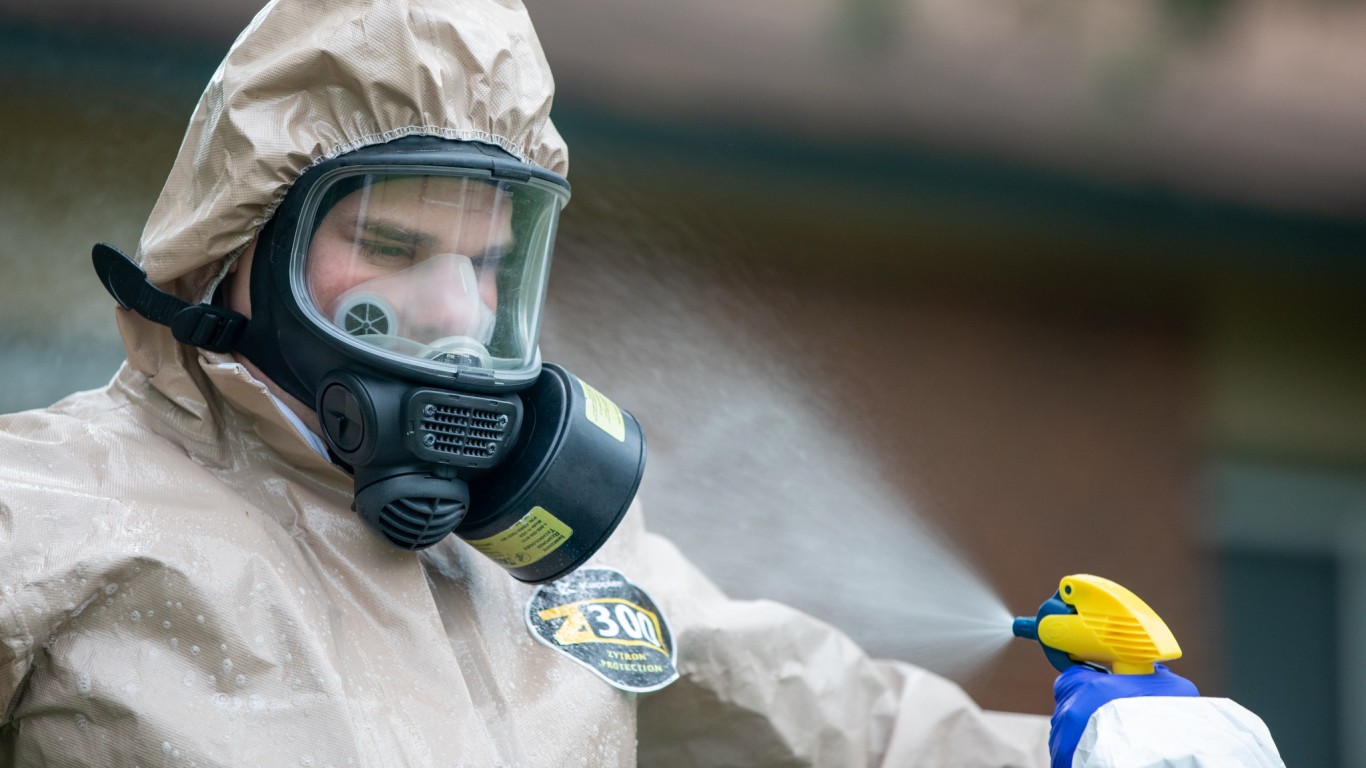

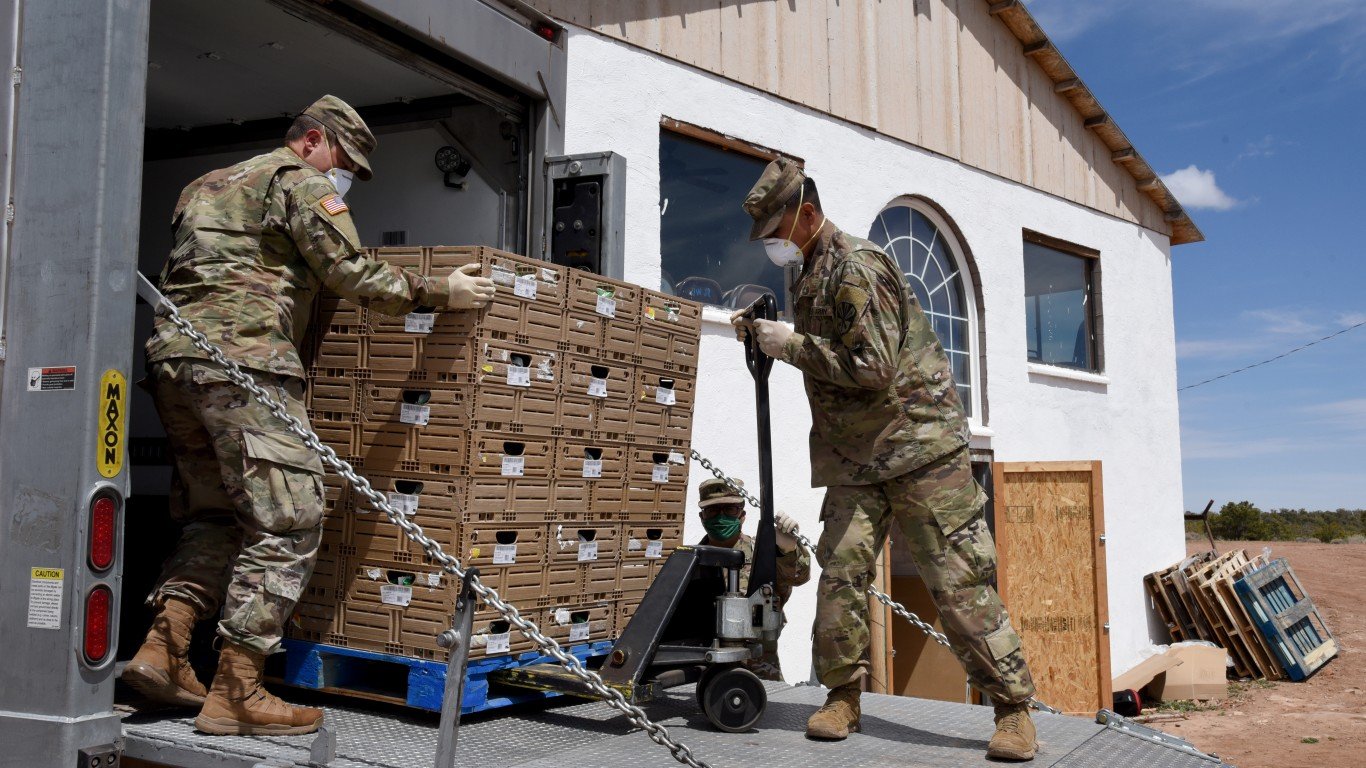
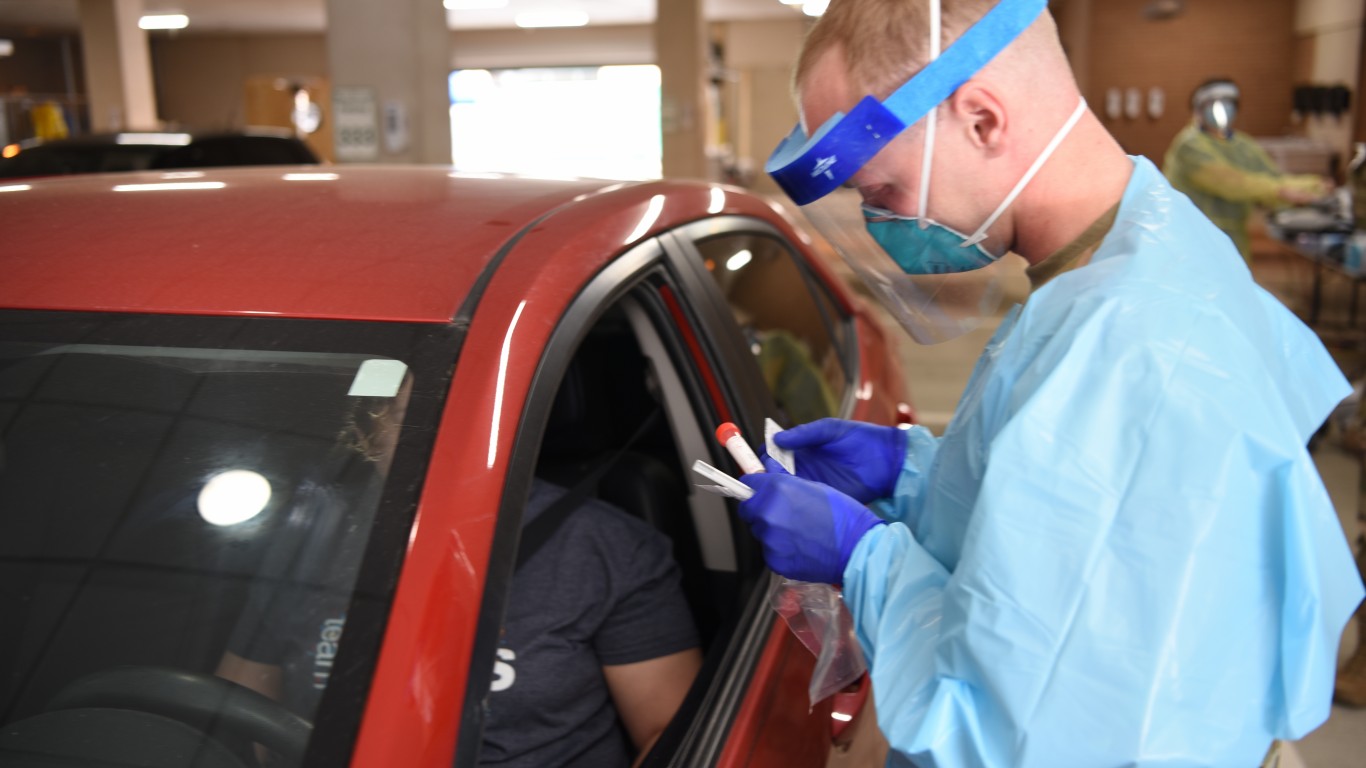





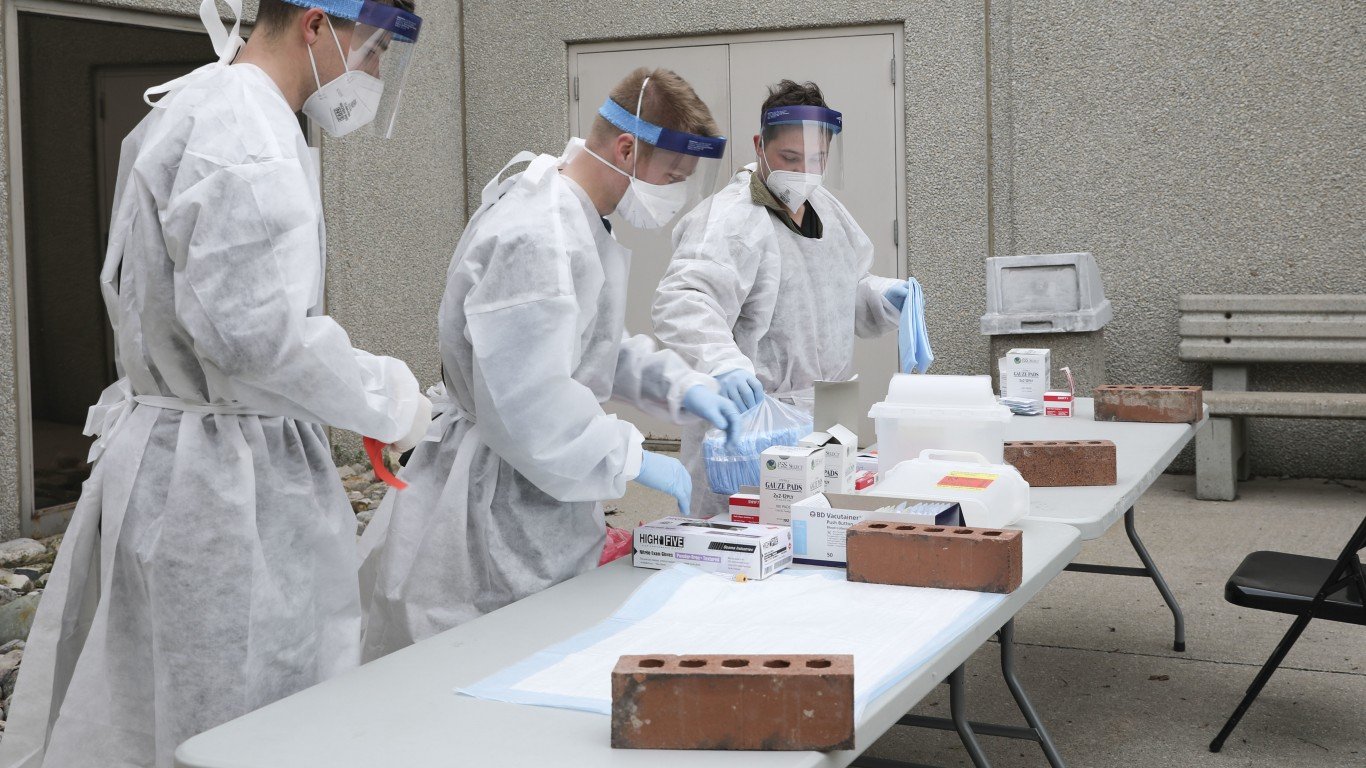
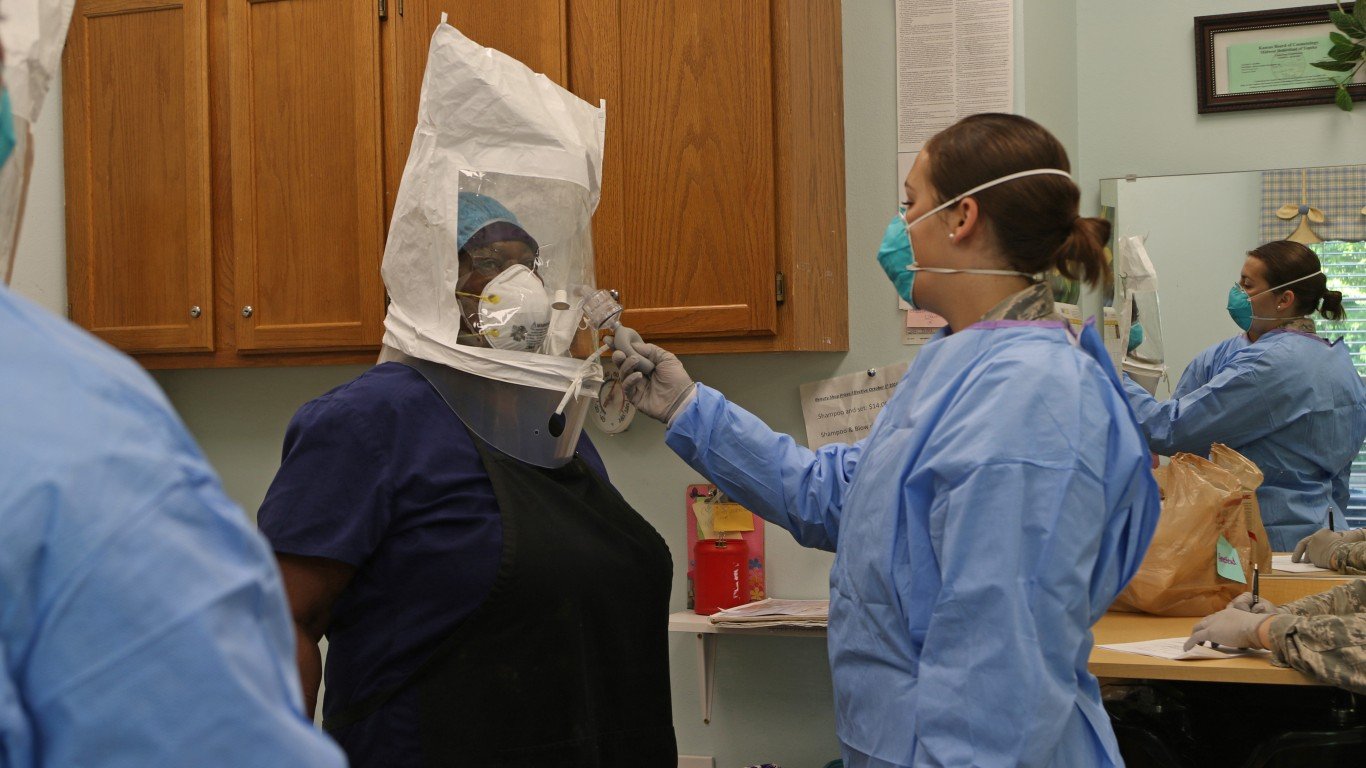

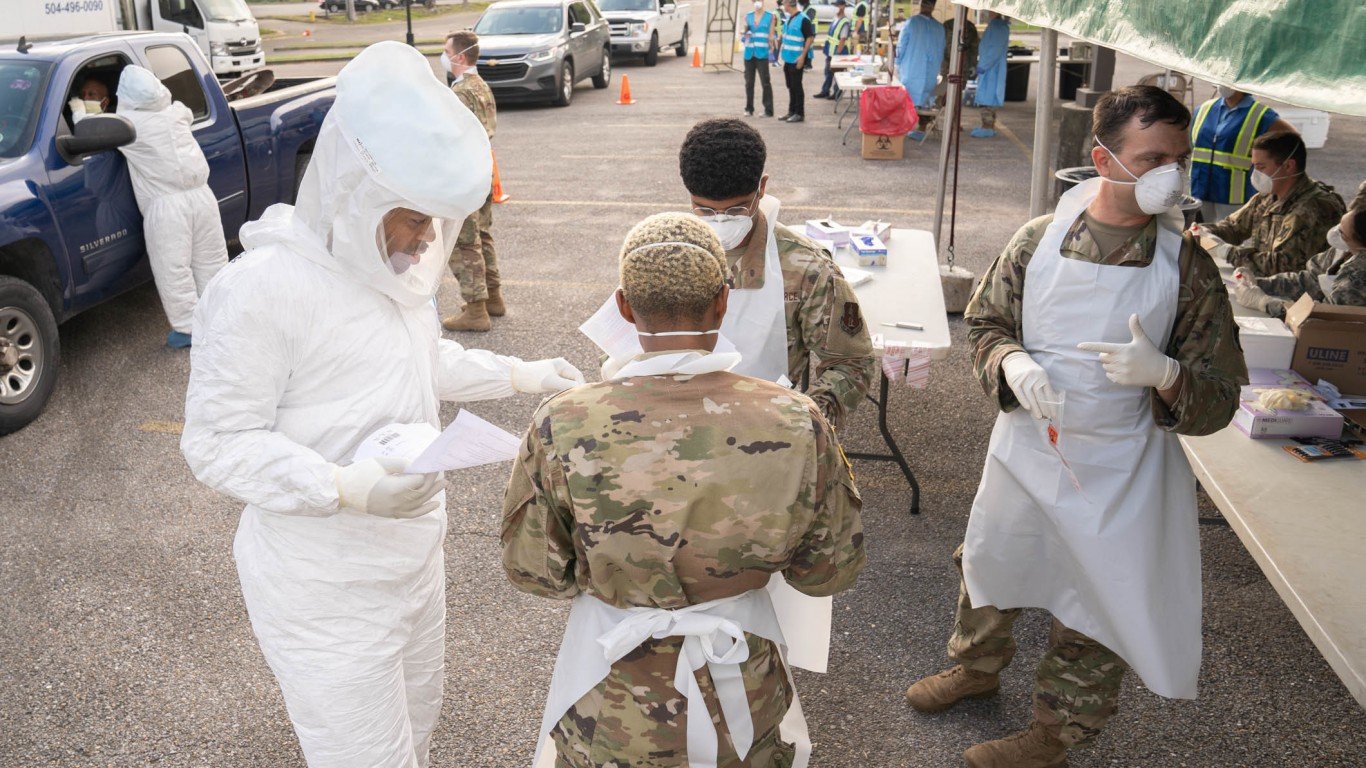
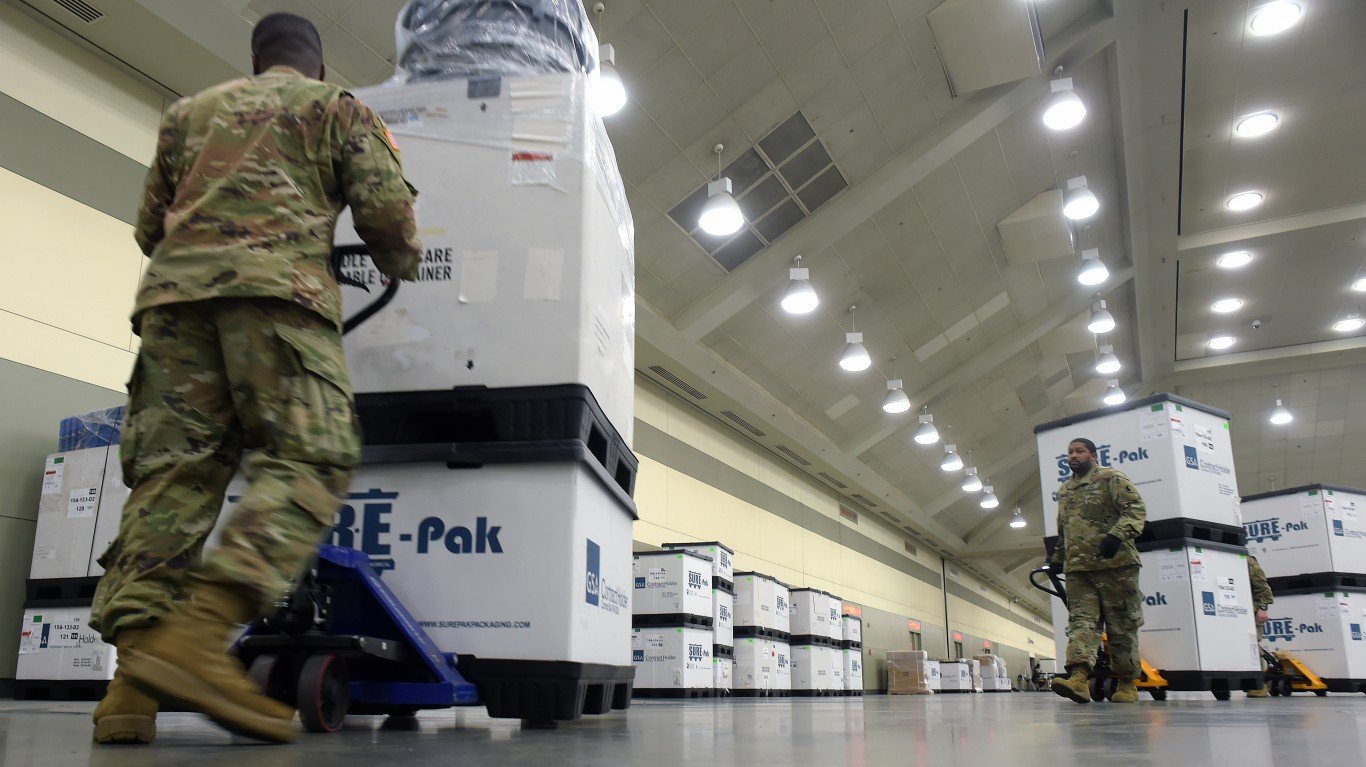
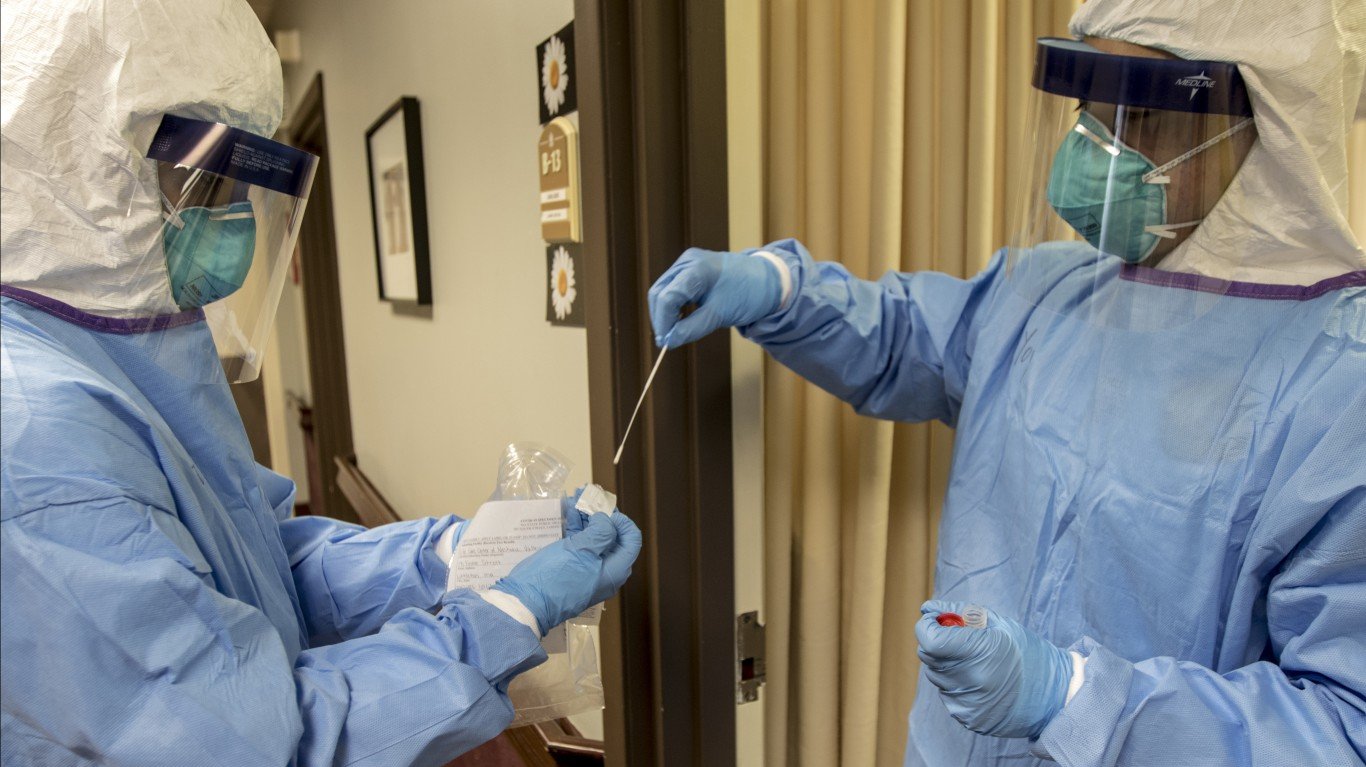

 24/7 Wall St.
24/7 Wall St.




 24/7 Wall St.
24/7 Wall St.
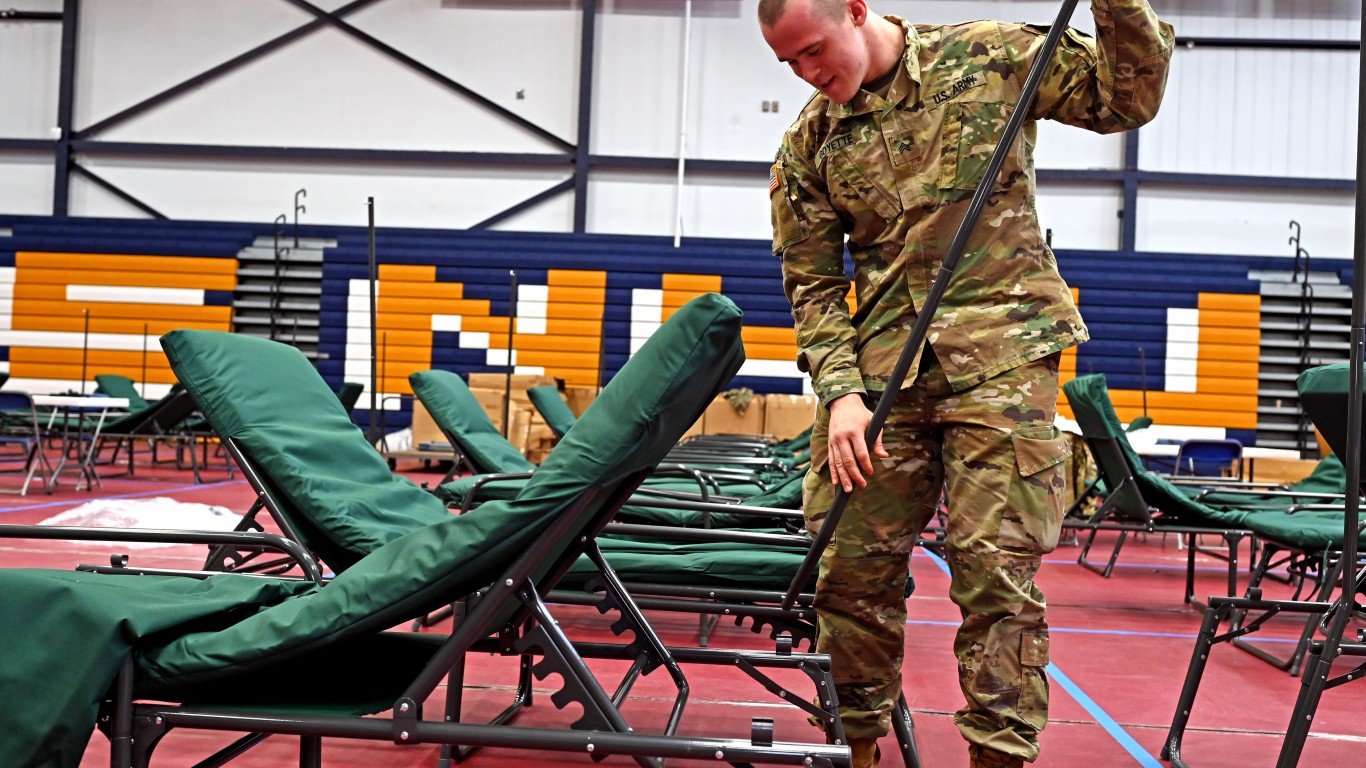



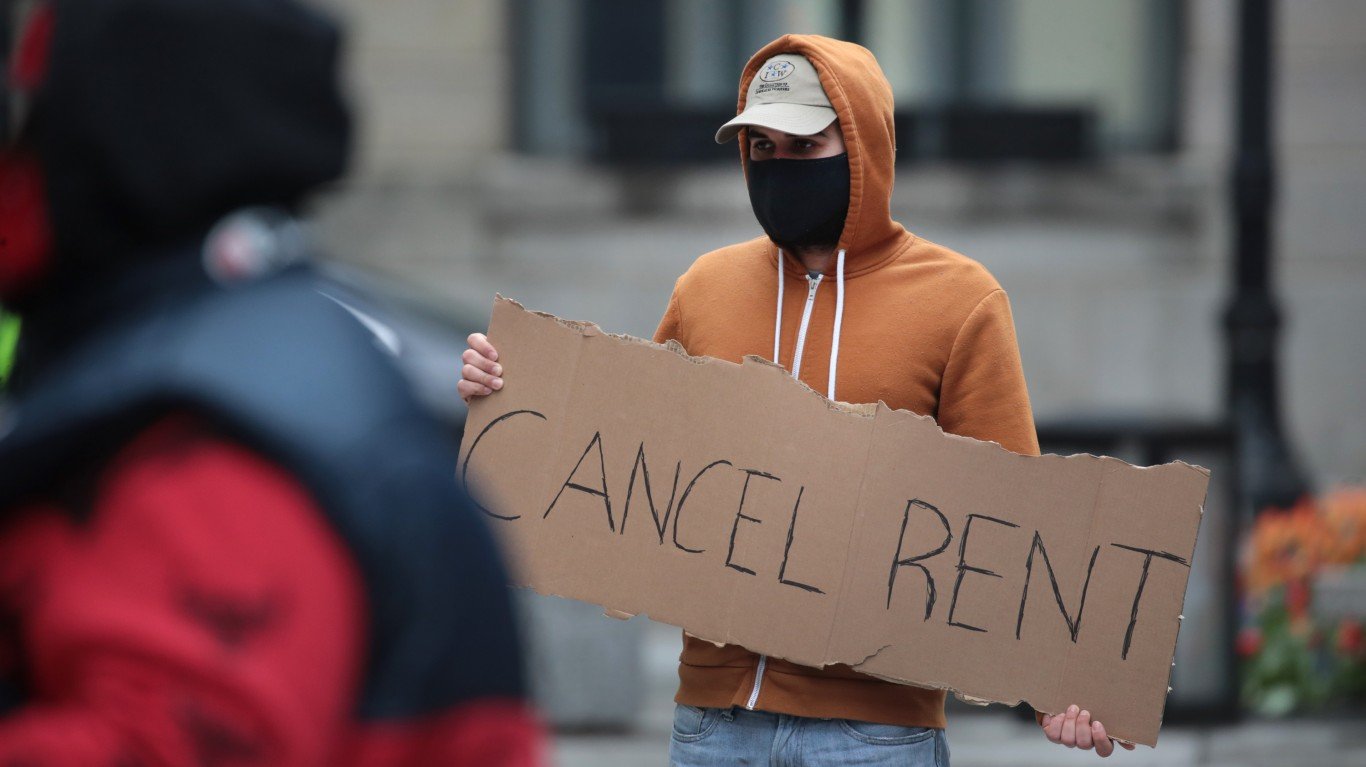 24/7 Wall St.
24/7 Wall St.